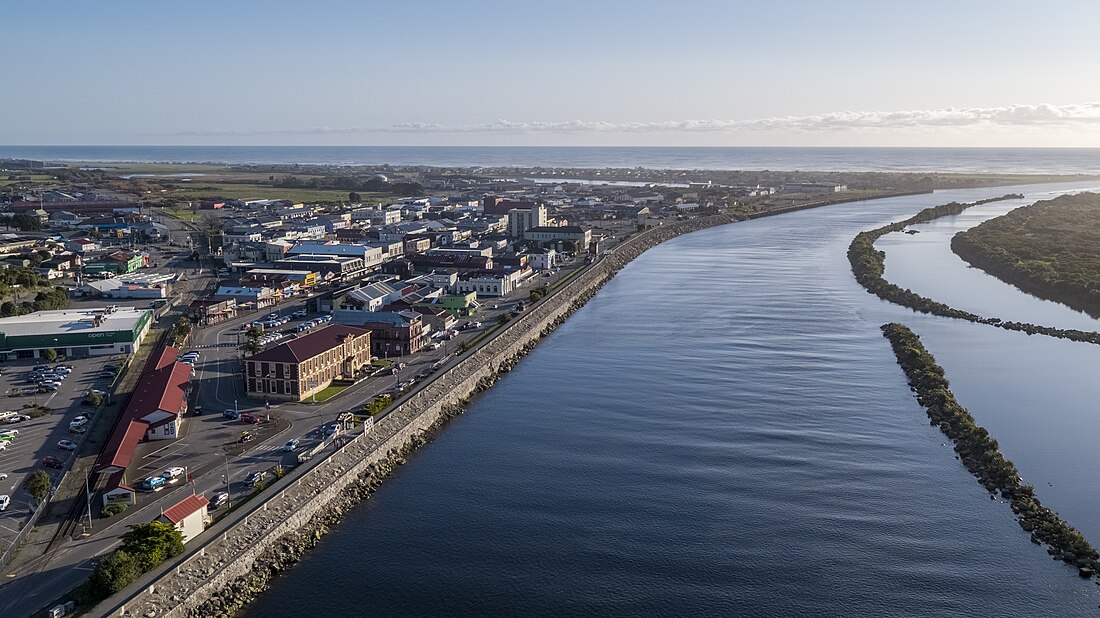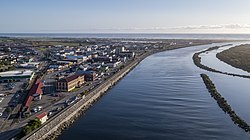Top Qs
Timeline
Chat
Perspective
Grey District
Territorial authority district in West Coast Regional Council, New Zealand From Wikipedia, the free encyclopedia
Remove ads
Grey District is a district in the West Coast Region of New Zealand that covers Greymouth, Runanga, Blackball, Cobden, and settlements along the Grey River. It has a land area of 3,474.31 square kilometres (1,341.44 sq mi). The seat of the Grey District Council, the local government authority that administers the district, is at Greymouth, where 59.0% of the district's population live.
The Grey District is on the West Coast of the South Island. It stretches from the south banks of the Punakaiki River in the north, southeast to Mt Anderson, north to The Pinacle, southeast to Craigeburn, in a southeast direction to Mt Barron, southwest to Jacksons and following the Taramakau River to the Tasman Sea.
The district is rich in history and character. Key industries are tourism, mining, agriculture, fishing, manufacturing and services industries. The main hospital for the West Coast is in Greymouth.
Remove ads
Demographics
Summarize
Perspective
Grey District covers 3,474.31 km2 (1,341.44 sq mi)[1] and had an estimated population of 14,400 as of June 2024,[2] with a population density of 4.1 people per km2. 8,500 live in Greymouth and 1,200 in Runanga.
Grey District had a population of 14,043 in the 2023 New Zealand census, an increase of 699 people (5.2%) since the 2018 census, and an increase of 672 people (5.0%) since the 2013 census. There were 7,128 males, 6,858 females and 57 people of other genders in 5,667 dwellings.[5] 2.6% of people identified as LGBTIQ+. The median age was 44.9 years (compared with 38.1 years nationally). There were 2,538 people (18.1%) aged under 15 years, 2,118 (15.1%) aged 15 to 29, 6,462 (46.0%) aged 30 to 64, and 2,922 (20.8%) aged 65 or older.[4]
People could identify as more than one ethnicity. The results were 90.7% European (Pākehā); 11.8% Māori; 1.4% Pasifika; 4.0% Asian; 0.5% Middle Eastern, Latin American and African New Zealanders (MELAA); and 4.2% other, which includes people giving their ethnicity as "New Zealander". English was spoken by 97.9%, Māori language by 1.8%, Samoan by 0.1% and other languages by 5.0%. No language could be spoken by 1.8% (e.g. too young to talk). New Zealand Sign Language was known by 0.6%. The percentage of people born overseas was 11.7, compared with 28.8% nationally.
Religious affiliations were 31.6% Christian, 0.6% Hindu, 0.3% Islam, 0.2% Māori religious beliefs, 0.3% Buddhist, 0.6% New Age, and 1.2% other religions. People who answered that they had no religion were 56.9%, and 8.4% of people did not answer the census question.
Of those at least 15 years old, 1,068 (9.3%) people had a bachelor's or higher degree, 6,711 (58.3%) had a post-high school certificate or diploma, and 3,357 (29.2%) people exclusively held high school qualifications. The median income was $34,200, compared with $41,500 nationally. 858 people (7.5%) earned over $100,000 compared to 12.1% nationally. The employment status of those at least 15 was that 5,433 (47.2%) people were employed full-time, 1,671 (14.5%) were part-time, and 279 (2.4%) were unemployed.[4]

Remove ads
History
Summarize
Perspective

The first buildings at the Grey River mouth were constructed by Ngati Wairangi Maori at Cobden. European settlement followed the discovery of coal and gold.
Greymouth, the district’s largest centre, lies beside the Tasman Sea and the Grey River. Greymouth experienced a rapid change in the cultural makeup of the region, reflecting an influx of migrants drawn to the gold rush, mining and related business opportunities.
As Greymouth developed, it became vulnerable to flooding. After two major floods in 1988, the Greymouth flood wall project was undertaken. Completed in 1990, the flood wall provides security for the town, and has allowed commerce to develop further.
A Māori settlement at Māwhera pā was long-established on the south bank of the Māwheranui river. When the first European explorers, Thomas Brunner and Charles Heaphy, arrived in 1846, they stayed at the pā, and were given food. Two years later, Brunner travelled up the river, which he renamed after Governor George Grey.
James Mackay negotiated with local Māori chiefs for the purchase of the West Coast region by the government, and the agreement was signed at Māwhera pā on 21 May 1860. One of the few Māori reserves was the land around the pā, now forming the main business district in Greymouth, and most of this still remains in Māori ownership.
Remove ads
Infrastructure
There are 619 km of road in the district, of which 358 km are sealed (2000s data).[10]
References
External links
Wikiwand - on
Seamless Wikipedia browsing. On steroids.
Remove ads


